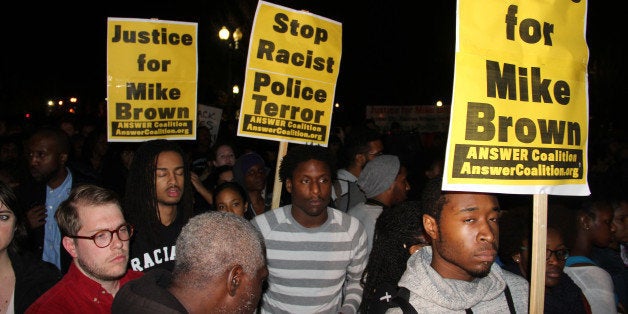
18-year-old Michael Brown had the dubious distinction of being slain three times. The first was, of course, his being gunned down by now former Ferguson police officer, Darren Wilson. The second slaying was in some ways just as painful to his family, friends, and the thousands that demanded Wilson be prosecuted. Police officials kicked into high gear with a loud, long, and vicious blame the victim campaign. They held press conferences, leaked documents, and orchestrated a well-oiled press campaign to depict Brown as having gang ties, smoked dope, dealt dope, had an arrest record, was a school troublemaker, and engaged in every kind of deviant behavior. They capped that by waving pictures to the national press that purported to show Brown robbing a convenience store moments before he was gunned down. The brutal inference was he was a bad guy who got what he deserved.
They got away with the second slaying by resting it squarely on the ancient, shop worn, but serviceable litany of stereotypes and negative typecasting of young black males. It's the shortest of short steps to think that if Brown could be depicted as a caricature of the terrifying image that much of the public still harbors about young black males, then that image seems real, even more terrifying, and the consequences are just as deadly.
The hope was that President Obama's election buried once and for all negative racial typecasting and the perennial threat racial stereotypes posed to the safety and well-being of black males. It did no such thing. Immediately after Obama's election, teams of researchers from several major universities found that many of the old stereotypes about poverty and crime and blacks remained just as frozen in time. The study found that much of the public still perceived those most likely to commit crimes are poor, jobless and black. The study did more than affirm that race and poverty and crime were firmly rammed together in the public mind. It also showed that once the stereotype is planted, it's virtually impossible to root out. That's hardly new either.
In 2003 and 2008, Penn State University researchers found that many whites are likely to associate pictures of blacks with violent crime. This was no surprise given the relentless media depictions of young blacks as dysfunctional, dope-peddling, gang bangers and drive-by shooters. The Penn State study found that even when blacks didn't commit a specific crime; whites still misidentified the perpetrator as an African-American. Immediately after the election of Obama the researchers still found public attitudes on crime and race unchanged. The majority of whites still overwhelmingly fingered blacks as the most likely to commit crimes, even when they didn't commit them.
The gunning down of unarmed young blacks is not the only lethal consequence of this warped public perception of black males. A Stanford study released days before Brown's killing found that a significant number of whites and non-whites were even more willing to cheer tough sentencing, three strikes laws, and draconian drug busts, when they perceive that the majority of those busted and imprisoned are black. Though no study has yet been done on it, it wouldn't surprise, in the backdrop of the disturbances in Ferguson following Brown's slaying and the mass demonstrations for Black lives Matter that a significant number of Americans would applaud the use of the massive war zone weaponry and tactics against American citizens that were used in Ferguson, as long as those citizens were perceived as young blacks.
The Third slaying of Brown was first St. Louis County Prosecutor Robert McCullough using every legal maneuver under the sun to duck, dodge, and foot drag on convening a grand jury and charging it with determining whether Wilson should be indicted. Next, McCullough deliberately skewed, tainted, mangled, and even falsified, the evidence and testimony to hector the jurors into clearing Wilson. Then, when the inevitable happened, namely a non-indictment of Wilson, he grandstanded before the world to both slander Brown and pretend that his office would cooperate with the Justice Department in its probe. There was even a sickening footnote to this little charade. Wilson was paid a mini-ransom to go on national TV and play act that he, not Brown, was the poor victim of the whole sorry mess. The Justice Department, to no surprise, drew the final curtain down on the Brown tragedy by declining to bring charges against him.
Meanwhile, two New York police officers are murdered and that effectively blew the wind out of the sails of a burgeoning forceful movement demanding an end to the police killing of unarmed blacks, such as Brown. The new shout now was it's police lives, not black lives, that matter. The ugly result of all this is that Brown set a hideous standard for dealing with dubious police shootings of young blacks. They can expect to be slain not one, two, but three times.
This post is part of the "28 Black Lives That Matter" series produced by The Huffington Post for Black History Month. Each day in February, this series will shine a spotlight on one African-American individual who made headlines in 2014 -- mostly in circumstances we all wished had not taken place. This series will pay tribute to these individuals and address the underlying circumstances that led to their unfortunate outcomes. To follow the conversation on Twitter, view #28BlackLives -- and to see all the posts as part of our Black History Month coverage, read here.
